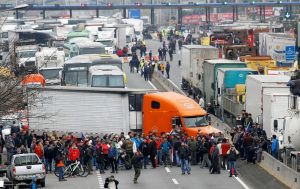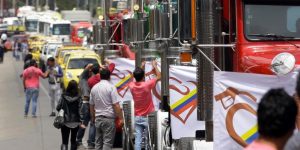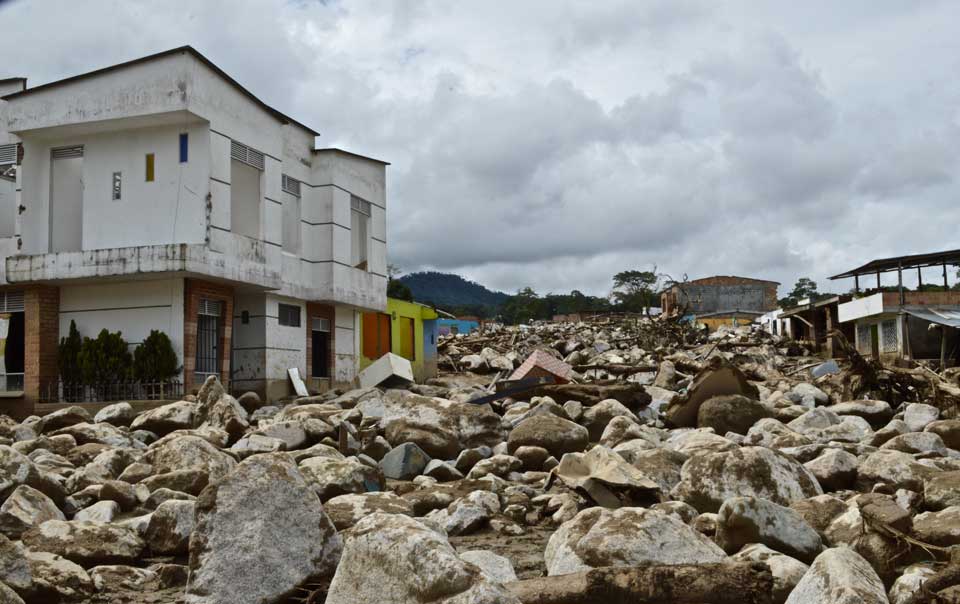
The strike finally ended after the government granted certain concessions to the truckers
Why does it cost more to get a container from the coast to Bogotá than to ship it from Beijing? Gerald Barr continues his journey through some of the curiosities and contradictions of life in Colombia by demystifying the truck strike.
On Colombia’s long and windy roads you get used to being stuck behind slow-moving trucks. But that’s put into perspective when they spend more than seven weeks not moving at all, with some actively blocking the road. Yes folks, the country has just seen another truck strike. Wasn’t there one last year? And the year before? Turns out there has been a truck strike every year for the past 15 years, as regular as Christmas, you might say, or rather a kind of “anti-Christmas” because nothing gets delivered.
The paro, which lasted 46 days, saw violent protests in Boyacá, the main road to Santander blocked, shipping containers backed up in ports like Buenaventura, and everyone in Bogotá complaining about the high price of tomatoes.
Some supplies made it through with non-striking trucks travelling in convoys with police escorts to protect them from supposed attacks from strikers. As usual there were some mysterious encapuchados (hooded youths) throwing stones and burning tyres, though no one knows if these are henchmen for the truckers or agents provocateurs sent to up the ante.
Back in Bogotá, without tomatoes, I try to figure it out. Who is right and who is wrong?
At heart I have huge respect for the truckers, having driven many of Colombia’s roads myself. Wrestling a big rig over La Línea, the high point between Ibagué and Armenia – and the main Andean pass between Bogotá and the Pacific ports – takes skill, an iron nerve and perfect timing.
And it’s not just mountain roads drivers have to deal with. For decades Colombian truckers have been on the conflict frontline, running the gauntlet of armed groups as they try to deliver their cargo. Every week there was a news report of a burnt-out truck, allegedly set alight at a guerrilla roadblock. And a truck driver is believed to have been shot dead by the Urabeños drug gang when it shut down roads in March this year.
Added to the physical dangers are the economic pitfalls. Colombia has one of the costliest supply chains in the world. In 2015 the country was ranked 126 out of 144 countries in terms of road infrastructure. Shipping a cargo container from the Pacific to Bogotá takes five days and costs US$3.60 a kilometre, three times the cost of an equivalent journey in Europe. In fact, it is cheaper to get a container 15,000km from Beijing to Colombia than the 500 clicks from the seaport to Bogotá.
To be fair, the road network is improving with the 4G – fourth generation – projects putting in new tarmac, dual carriageways and tunnels. But a lot of this work is being financed upfront from road tolls which explains the eye-wateringly high cost of using main roads. Big trucks pay around US$1 for every 10 kilometres they drive.
These high tolls and fuel costs (the highest in South America) are pushing owner-drivers to the wall, particularly since cargo charges have barely increased since 2009. Some of the key demands of the strikers are lower tolls and an official minimal cargo rate. You might imagine the public is on the truckers’ side, but I can’t find any sympathisers among friends and colleagues in Bogotá.
“Another year, another strike. What do they want now?” says a friend, angry at still waiting for his kitchen units from Medellín. The mainstream media is no more sympathetic. Yesteryears’ hero trucker – the one braving guerrilla roadblocks – is now recast as an economic terrorist holding the country to ransom and conspiring to keep Bogotá out of tomatoes (at least quality ones).
The government has compelling reasons to resist the strike, even after 40 days at around US$3 million a day in lost commerce. In inland cities like Bogotá, transport represents a large chunk of the cost of goods. Giving into the strikers’ demands will increase the canasta familiar – the family food basket – by 30%, says the minister of transport, refusing to set minimum freight tariffs.
This smacks of hypocrisy. The government is happy to laud free market principles and resist the “protectionism” of set freight tariffs (“let the market decide” it proclaims), but then it forces the truckers to fund the bulk of the road-building. That building work itself is managed through a murky system of highway concessions and political patronage able to increase tolls at will (by 300% in two years, in some cases) with no alternative roads. In Colombia you can’t choose to take the toll road. It is the only road. Hardly a “free market”.

Truckers went on strike to improve what they believe are untenable working conditions.
One thing both parties agree on is that there are too many trucks on the road. According to some sources, the country shifts 220 million tonnes of cargo a year but has trucking capacity of 400 million tonnes. Another estimate claims there are 20,000 smoky old obsolete trucks still grinding over the roads. That oversupply has forced down cargo rates, which is great for the canasta familiar, but bad for the truckers and the environment.
Money for scrap?
But how to get the old trucks off the road? That seems to be a slippery problem, and I know I’m not the only one who fantasises about a giant machine to crush them out of existence (particularly when I’m stuck behind a behemoth breathing its black smoke on the road from Guaduas).
They do need to be scrapped, but the question is, how? The World Bank looked into this in a discussion paper ‘Can Vehicle Scrappage Schemes be Successful?’, to which the answer is “not very”, since offering cash incentives for junking old clunkers is counterproductive: it invariably leads to more, not less, obsolete haulage.
It is not hard to figure out why. In Colombia, for example, the government offers a US$30,000 benefit for an old truck to be scrapped. They also have a law that states you need to scrap an old truck before you can buy a new one, or at least buy the “rights” to an old scrapped truck, even if it was not yours (someone else with an old truck can sell you the rights). Bingo, old trucks now have an intrinsic value and are back in business, even if scrapped now or in the future. This is the truckers’ equivalent of a hedge fund, which perhaps the World Bankers are more familiar with.
In Colombia, entrepreneurial zeal combined with criminal gangs and corruption at some local transit offices has led to abuse of the scrapping scheme and the Cartel de Chatarrización (Scrap Cartel) which has allegedly raked in billions of pesos with dodges such as scrapping “virtual trucks” (trucks which exist only in fake vehicle registration files), passing off old buses as large artics, or simply re-scrapping the same old truck several times and forging the documents (and in between using it to move cargo at a snail’s pace over Colombian roads).
In a final twist, the government accuses the union leaders behind the strike of actually running the Scrap Cartel, a claim echoed by trucker groups not participating in the strike. Whether it’s true or not, the state’s hands are hardly clean on this issue either. Government officials have known for years about the Scrap Cartel but have done little to fix it. This has ledt to even more truck oversupply, further driving down freight charges.
Then on day 46 it’s all over. An agreement has been rolled out. The truck scrapping scheme will gear up but with stricter checks against corruption, some road tolls will fall for large trucks, the ministry will establish “reference costs” for freight charges (not quite fixed rates) and truckers will get some labour benefits. Will it all work? We’ll find out if they strike again next year. Meanwhile, if you are stuck behind a smoky old truck on the road from Guaduas think of it this way: it’s the price you pay for those cheap tomatoes.
By Gerald Barr





